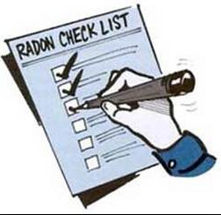So often new home buyers make the assumption that the brand new construction home they are buying protects them from radon. That assumption could be further from the truth. Consider buying a home from a home builder that build radon-resistant new construction homes!

More and more home builders across the United States are building new homes that prevent radon from entering the home. Home builder's have come to realize that their customers need a safer, healthier, radon-resistant home. The EPA has launched a campaign that promotes the concept that living green is also breathing clean, healthy indoor air. It is environmentally responsible to chose to protect familys' from lung cancer.
What's the big deal about radon? Radon is extremely dangerous because it is odorless and an invisible gas that ranks as the number one home hazards for American homes, according to a Harvard University study. While radon dissipates outside in an open air environment, it gets trapped inside homes and buildings. Hazardous radon levels are detected in one out of 15 American homes. Radon is the leading cause of lung cancer for non-smokers. The U.S. surgeon General has made January "Radon Action Month".
If you are buying an older home you can hire a radon professional to do an inspection. Find certified professionals with the National Environmental Health Association-National Radon Proficiency Program or the National Radon Safety Board.
Let's see how much you know about Radon! Answer these True or False questions.
- Radon levels within a building often change on a day-to-day basis. (True or False) True: Because of changes and air pressure through-out the building during different times of the year Radon levels in the home can increase or decrease
- The highest indoor levels are often found during the winter when you are using heat to warm your home. (True or False) True: This is because during the winter months most homes windows and doors are closed with a thus creating for lack of air flow trapping Radon and other natural occurring gases inside the home.
- Short term test kits are the quickest way to test your home for radon. (True or False) True: They will give you a quick reading, but reading over time are more reliable.
- 24 hours is enough time to determine if your home has a radon problem. (True or False) False: You need at least 48 hours at a minimum.
- There are long term tests that remain in your home for more than 90 days, and are more effective than short term tests. (True or False) True because radon levels vary depending on the weather, etc.
- If a long-term test yield results of 4pCi/L or higher, the EPA recommends correcting the problem. (True or False) True
- The best place to test for radon is n the lowest part of the home. (True or False) True: Because Radon is a natural occurring gas created by decomposing Uranium underground the highest amounts of Radon Gases enter your home would be coming from the lowest point.
- It is smart to also test rooms that are regularly occupied such as a family room, den, etc. (True or False) True- It's important to be safel in your whole house.
So you live in a state that has statewide Radon-Resistant New Construction- RRNC Codes? As of June, 2014, the EPA list the following states: Illinois | Maryland | Michigan | Minnesota | New Jersey | Oregon | Washington.
There are 18 states that DO NOT have statewide RRNC codes, but DO have local jurisdictions that have RRNC codes. They are: Alabama | Colorado | Idaho | Iowa | Kansas | Missouri | Montana | Nebraska | New Mexico | New York | Ohio | Oklahoma | Pennsylvania | South Carolina | Tennessee | West Virginia | Wisconsin | Wyoming
There are 24 states and 3 District/Territories that DO NOT have statewide or local jurisdictions that have RRNC codes. They are: AK, AZ, AR, CA, CT, DE, DC, GA, GU, HI, IN, KY, LA, MA, MS, NV, NH, NC, ND, PR, SD, TX, UT and VT.
What are some of the things a builder should do to make a Radon-Resistant New Construction home?
1. GRAVEL: A layer of clean, coarse gravel below the foundation.
2. Plastic Sheeting or Vapor Retarder: A heavy duty plastic sheeting or vapor retarder over the gravel to inhibit radon and other soil gases from entering the home. What is the best vapor barrrier that is specifically engineered to block radon, and has the tests to prove it? Raven Industries VaporBlock 20+. This vapor retarder/barrier far exceeds any 6 mil polyethylene plastic.
3. A Vent Pipe: A vent pipe installed vertically from the gravel layer through the house's conditioned space and roof. This safely vents radon and other soil gases outside hte hosue.
4. Sealing and Calking: Sealed all openings, creacks and crevices in the concrete foundation and walls with polyurethane caulk to prevent radon and other soil gases from entering the home.
5. Junction Box: Installed an electrical junction box (outlet) in the attic for use with a vent fan, should, after tesing for radon, an more robust system be needed.

Check out the EPA's website to learn more about controlling radon in your home.

